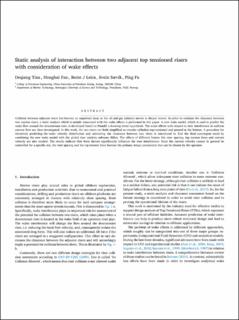| dc.contributor.author | Leira, Bernt Johan | |
| dc.contributor.author | Sævik, Svein | |
| dc.contributor.author | Fu, Ping | |
| dc.contributor.author | Tian, Deqiang | |
| dc.contributor.author | Fan, Honghai | |
| dc.date.accessioned | 2020-04-07T09:34:29Z | |
| dc.date.available | 2020-04-07T09:34:29Z | |
| dc.date.created | 2020-01-20T14:01:45Z | |
| dc.date.issued | 2019 | |
| dc.identifier.citation | Ocean Engineering. 2020, 195 | en_US |
| dc.identifier.issn | 0029-8018 | |
| dc.identifier.uri | https://hdl.handle.net/11250/2650621 | |
| dc.description.abstract | Collision between adjacent risers has become an important issue as the oil and gas industry moves to deeper waters. In order to estimate the clearance between two marine risers, a static analysis which is mainly concerned with the wake effects is performed in this paper. A new wake model, which is used to predict the wake flow around the downstream riser, is developed based on Prandtl's shearing stress hypothesis. The wake effects with respect to riser interference in uniform current flow are then investigated. In this work, the two risers are both simplified as circular cylinders top-tensioned and pinned at the bottom. A procedure for iteratively predicting the wake velocity distribution and estimating the clearance between two risers is introduced to find the final convergent result by combining the new wake model with the global riser analysis software Riflex. The effects of different factors like riser spacing, top tension force and current velocity are also studied. The results indicate that these factors significantly influence the riser interference. Since the current velocity cannot in general be controlled for a specific site, the riser spacing and the top tension force become the primary design parameters that can be chosen by the operator. | en_US |
| dc.language.iso | eng | en_US |
| dc.publisher | Elsevier | en_US |
| dc.rights | Attribution-NonCommercial-NoDerivatives 4.0 Internasjonal | * |
| dc.rights.uri | http://creativecommons.org/licenses/by-nc-nd/4.0/deed.no | * |
| dc.title | Static analysis of interaction between two adjacent top tensioned risers with consideration of wake effects | en_US |
| dc.type | Peer reviewed | en_US |
| dc.type | Journal article | en_US |
| dc.description.version | acceptedVersion | en_US |
| dc.source.volume | 195 | en_US |
| dc.source.journal | Ocean Engineering | en_US |
| dc.identifier.doi | 10.1016/j.oceaneng.2019.106662 | |
| dc.identifier.cristin | 1777894 | |
| dc.description.localcode | © 2020. This is the authors’ accepted and refereed manuscript to the article. Locked until 11 November 2021 due to copyright restrictions. This manuscript version is made available under the CC-BY-NC-ND 4.0 license http://creativecommons.org/licenses/by-nc-nd/4.0/ | en_US |
| cristin.unitcode | 194,64,20,0 | |
| cristin.unitname | Institutt for marin teknikk | |
| cristin.ispublished | true | |
| cristin.fulltext | original | |
| cristin.qualitycode | 1 | |

